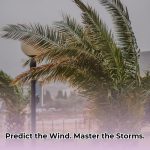Los Angeles’ winds are famously unpredictable, causing challenges for airline pilots and kite enthusiasts alike. This article explores the factors influencing LA’s wind patterns, compares different weather forecasts, and explains potential discrepancies. We’ll provide guidance on interpreting wind reports and long-range predictions, offering practical insights for dealing with the city’s breezy nature. Whether you’re a pilot, a wind energy professional, or simply curious about tomorrow’s wind conditions, this guide will help you understand LA’s often-complex wind behavior. For more on advanced wind forecasting, see this helpful resource on wind intensity forecasting.
Unpredictable Winds: Analyzing Atmospheric Dynamics
Navigating the winds of Los Angeles can be an exercise in uncertainty. A calm breeze can quickly turn into a gusty whirlwind. The challenge lies in the complex atmospheric dynamics that influence wind patterns, leading to forecast discrepancies.
Mountains, Oceans, and Urban Landscapes: Exploring Land and Sea Breezes
Los Angeles is nestled between the Pacific Ocean and the San Gabriel Mountains. This unique geographical configuration creates a complex interplay of wind patterns. The mountains act as natural funnels, channeling air currents. Simultaneously, the ocean generates sea breezes, adding another layer of complexity. The result is a constantly evolving wind dynamic that varies throughout the day and across different city areas.
LA Wind Forecasts: A Comparison of Online Resources
Several online resources offer Los Angeles wind maps, providing real-time data and forecasts. However, these resources often present differing information. Each utilizes different models and data sets, leading to variations. Popular options like Windy.app, AccuWeather, Wunderground, Windfinder, and Windy.com employ diverse modeling techniques, which can result in significant disagreements.
Discrepancies in Los Angeles Wind Maps: The Impact of Terrain and Data Resolution
Differences in online wind maps arise from several factors, including LA’s terrain and data resolution. Models vary in their ability to account for local terrain features. Accuracy depends on the underlying data, with satellite imagery resolution playing a crucial role. Higher-resolution imagery typically provides better data, but even with advanced tools, limitations exist. Computer models can struggle to perfectly capture the interactions between the ocean, mountains, and urban heat island effect.
The Importance of Accurate LA Wind Forecasts: Stakeholders and Applications
Understanding LA’s winds has significant implications for multiple sectors, including aviation and emergency management. Accurate wind predictions are vital for day-to-day operations and long-term planning:
| Stakeholder Group | Immediate Needs | Long-Term Planning & Needs |
|---|---|---|
| Weather Forecasters | Real-time data for forecast refinement | Development of advanced forecasting models |
| Renewable Energy Companies | Real-time wind speed for power generation | Wind resource assessment for project development |
| Aviation Authorities (LAX) | Real-time wind conditions for safe operations | Wind shear detection and predictive system enhancement |
| Emergency Response Organizations | Wildfire risk assessment and response planning | Early warning systems for high-wind events |
Accurate, long-range wind forecasts support long-term planning, such as developing renewable energy infrastructure and improving emergency response protocols.
The Future of LA Wind Forecasting: Advancements in Modeling and Data Collection
The pursuit of accurate Los Angeles wind forecasting is an ongoing scientific process. Scientists are continuously refining models by incorporating detailed local conditions, employing higher-resolution data, and improving the capacity to capture interactions between the ocean, mountains, and urban environments. Sophisticated modeling techniques and enhanced data integration are key. A network of precise sensors across the region, feeding real-time data into models, could significantly improve prediction accuracy.
Interpreting Los Angeles Wind Forecasts: A Practical Guide
Key Takeaways:
- Los Angeles winds predominantly come from the southwest, influenced by time of day, proximity to the ocean, and broader weather patterns.
- Afternoon winds are generally stronger.
- Various weather sources offer different detail levels; understanding their strengths is crucial.
- These variations are important for aviation, marine activities, emergency management, and renewable energy.
Understanding LA’s Windy Nature: Factors and Influences
Los Angeles’ wind patterns are a complex interaction between the Pacific Ocean’s sea breezes, the city’s geographical features, and atmospheric pressure systems. Deciphering information from various sources requires a strategic approach.
A Multi-Source Approach: Deciphering the Data
Several online sources provide Los Angeles wind forecasts, each with strengths and weaknesses. Windfinder offers detailed hourly predictions for precise planning. Windy.com provides a broader visual overview. Wunderground focuses on current conditions. Utilizing each service effectively creates a comprehensive understanding. Combining information from multiple sources provides a clearer, more accurate forecast. Cross-reference data to identify consistent patterns and potential discrepancies.
Spotting the Differences: Identifying Variances
While sources generally agree on wind direction, variations in speed and timing can occur. Differences may stem from measurement locations, sensor types, or inherent limitations in predicting dynamic systems. Slight speed variations between Windfinder and Windy.com are common. This highlights the need for nuanced interpretation, considering specific requirements.
Actionable Insights for Different Stakeholders: Applications
Understanding LA’s wind patterns is crucial for sectors requiring effective data visualization.
- Aviation: Pilots at LAX require real-time data for safe operations, prioritizing sources like Windfinder for detailed hourly information.
- Marine Activities: Boat operators and surfers need forecasts for planning, favoring quick overviews from Windy.com.
- Emergency Management: First responders require real-time data from Wunderground to manage wildfires and emergencies.
- Renewable Energy: Companies depend on long-term data for investment and operational efficiency, requiring detailed analysis across sources.
Managing Uncertainty: Risk Assessment and Mitigation
Wind forecasting involves inherent uncertainty, requiring proactive risk mitigation.
| Technology/System | Risk Category | Probability | Impact | Mitigation Strategies |
|---|---|---|---|---|
| Wind Forecasting Models | Prediction Accuracy | Medium | Medium | Continuous model validation using real-time data; diversification of data sources. |
| Aviation Systems | Reliance on Forecast Accuracy | Low | High | Redundant weather monitoring systems; contingency plans for adverse conditions. |
| Wildfire Management Systems | Reliance on Forecast Accuracy | Medium | High | Integration of multiple weather data streams; real-time monitoring of ground conditions and fire behavior. |
By understanding source strengths and limitations, and cross-referencing information, you improve your interpretation of Los Angeles wind forecasts.
Los Angeles Wind Patterns and Renewable Energy Production: Optimizing Wind Turbine Placement
Key Takeaways:
- Los Angeles aims for a 100% renewable energy grid by 2045.
- Wind energy is a significant component of this transition.
- Understanding local wind patterns is crucial for wind turbine placement and energy generation.
- Optimizing wind turbine location maximizes energy output and minimizes environmental impact.
- Wind Turbine Fire: Questions About Safety Spark Debate - October 31, 2025
- Vertical Axis Wind Turbine Design: Improving Efficiency and Overcoming Limits - October 29, 2025
- Wind Turbine to Power Home: Nacelle Design Improvements Advance - October 26, 2025
















